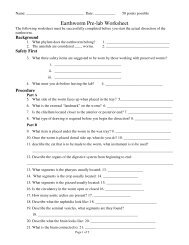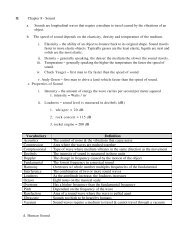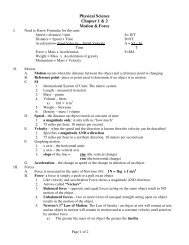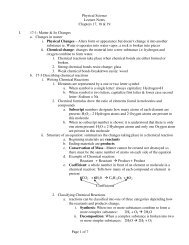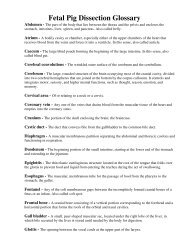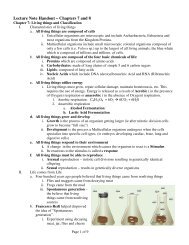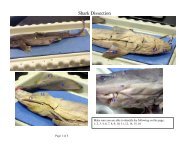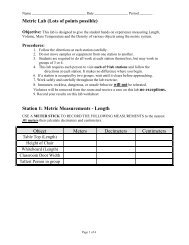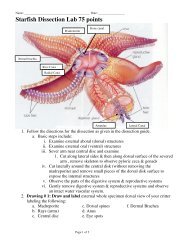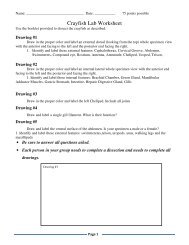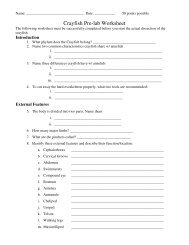Physical Science Lecture Notes - Mr.E Science
Physical Science Lecture Notes - Mr.E Science
Physical Science Lecture Notes - Mr.E Science
Create successful ePaper yourself
Turn your PDF publications into a flip-book with our unique Google optimized e-Paper software.
Nebula ProtostarLife Cycle of a StarSmall & Medium Star Red Giant White Dwarf Black DwarfNeutron StarRed Giant Super Red Giant Super NovaBlack HoleD. History of the Universe1. Galaxy – is a group of 100’s of Billions of starsa. Three main shapesi. Spiral, Elliptical and irregularb. 100’s of billions of galaxies make up the known universe2. Big Bang Theorya. The Big Bang Theory says that the entire universe began 15 to 20 billion yearsago.b. Scientist have viewed thousands of galaxies and can measure the fact that allgalaxies are moving away from each other.c. If you could run the film “backwards”, it would appear that all of the galaxiescome together at a single incredibly dense point.d. Scientist CANNOT Explain where this dense point came from. WE CAN:i. Gen 1:1 – In the beginning, God created the Heavens and the EarthII.Chapter 23: The Solar SystemA. Observing the Solar System1. Greeks watched the stars move across the sky and noticed five “stars” that wanderedaround and did not follow the paths of the normal stars. They called them Wander Stars“planets”.2. “Wandering Stars” were: Mercury, Venus, Mars, Jupiter and Saturn3. Greek Astronomer Ptolemy (pronounced “tall-oh-me) believed: Geocentric - Earthcentered Solar system4. Copernicus: Polish Astronomer believed: Heliocentric – Sun centered Solar System5. Galileo: confirms Copernicus beliefa. He used telescope to see 4 moons revolving around Jupiter and that Venus wentthrough phases just like our mooni. These things couldn’t happen if we were Geocentric, only if we wereheliocentric6. Brahe, an astronomer, made very precise measurements of the location of the planetsfor over twenty years.7. Kepler, a mathematician, used Brahe numbers and determined that the orbits of theplanets were elliptical not perfect circles.8. Newton – determines that planets stay in orbit because of Inertia and Gravitya. Inertia – an object at rest stays at rest, an object in motion stays in a straight linemotion, until acted on by an outside force.b. Gravity – the attraction of two objects. The strength of gravity depends on themasses each object possess.Page 3 of 5
Planets<strong>Physical</strong> <strong>Science</strong> Need to KnowsMercury-Venus-Earth-Mars-Asteroids-Jupiter-Saturn-Uranus-Neptune-PlutoI. The Inner Planets-The Terrestrial Planets: Mercury, Venus, Earth and MarsMercury: Closest to the sun, about the size of our moon, fastest revolution, daytimetemp 427 C & night temp –170 CVenus: Earth’s “twin” and one of the hottest surfaces, thickest atmosphere of terrestrialPlanets, very slow rotation (243 Earth days) & retrograde rotation, Called the“Morning & the Evening Star”Earth: Intelligent life, liquid waterMars: The “Red” planet, live TV from the surface, largest volcano in solar system:Olympus MonsAsteroid Belt: In orbit where a planet should be, range in size from 1000 km ( 1/3 thesize of our moon) to dust sizeII. The Outer Planets-Pluto & The Gas Giants: Jupiter, Saturn, Uranus, & NeptuneJupiter: Largest of the Jovian Giants, large Red Dot is a massive storm, we viewedbreakup of comet crash onto its surface.Saturn: Rings are horizontal, fastest rotation causes poles to be flatten and equator tobulge, least dense- it would float in waterUranus: Super heated ocean of water 8,000 km thick, Blue planet w/ atmospherefeatureless &11,000 km thick. Axis is tilted almost 90 degrees.Neptune: Its orbit was used to calculate the position and existence of Pluto, 5 verticalrings, Blue planet w/ atmosphere with visible changing clouds. Its largestmoon is Triton which has retrograde revolution.Pluto: Last known planet discovered in 1930, only terrestrial planet in outer planets,“Twin” planets w/ large moon Charon. It has officially been declassified and isno longer a “planet”.Artificial SatellitesMariner 2 – 1962, first probe of VenusMariner 4 - 1965, first probe of MarsMariner 7- 1969, explored Mars, sent back aerial photos of surfaceMariner 9 – 1971, Explored Mars, sent back photos of two Martian moonsMariner 10- 1974, three passes of MercuryViking 1 – 1975 – first spacecraft to land on MarsViking 2 – 1975 , landed on and explored MarsPioneer 10- 1983, First man-made object to leave our solar system, explore outer planetsPioneer 11 – explored outer planetsVoyager 1- explored outer planetsVoyager 2 – explored outer planetsMagellan – orbit around VenusPathfinder-1997- Landed on Mars, released microwave-sized remote controlled rovercalled “Sojouner”Page 5 of 5



